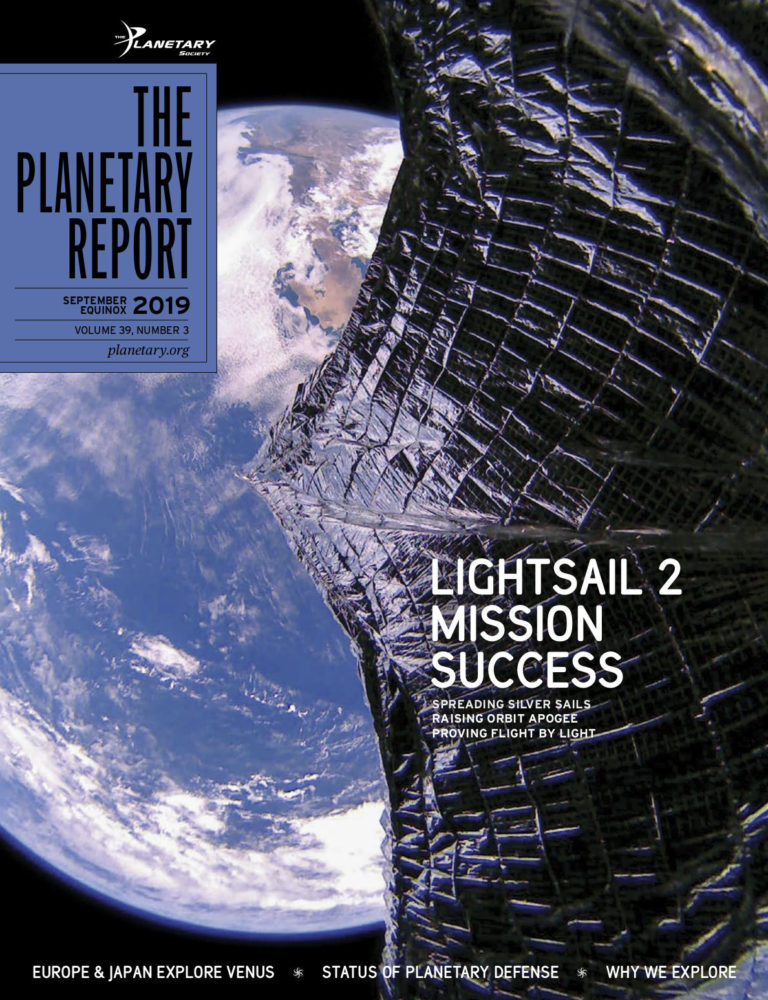Venus’ Ocean of Air and Clouds
Deep, Dynamic Currents Revealed by Venus Express and Akatsuki
Venus’ appearance is deceptive. The history of scientific research about Venus is full of mistaken assumptions that are sooner or later refuted by new observations. Ancient civilizations wrongly interpreted the morning and evening stars as 2 stars. Giovanni Cassini claimed to have observed moons. More recently, scientists assumed that Venus’ reflective clouds prevented solar energy from reaching its surface, leaving it cold. Its surface is actually hotter than Mercury’s surface. Even today, sophisticated numerical models that work to predict the behavior of atmospheres on other planets are unable to reproduce even basic properties of the atmosphere of Venus.
Consider one particular mystery. Why, when Venus is the slowest-rotating planet in the solar system, does its atmosphere whirl around it at 300 kilometers (200 miles) per hour, 60 times faster than the planet’s spin? Understanding this atmospheric superrotation has become a more urgent goal in recent decades because it also happens on Titan and even in exoplanetary atmospheres, especially those tidally locked to their stars.
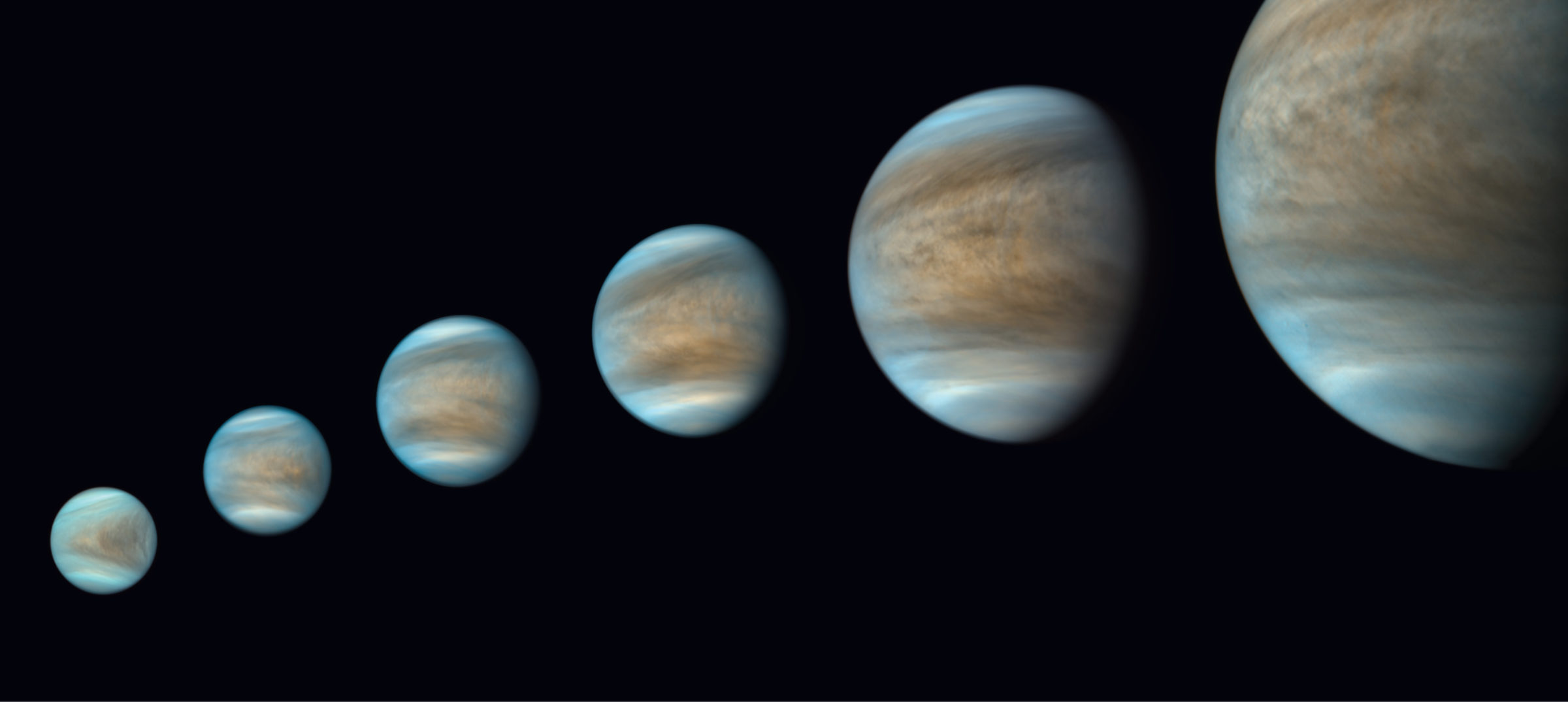
New Orbiters
More than 20 space missions visited Venus from 1962 to 1999, but there was a long gap in orbital missions after NASA’s Magellan entered the atmosphere in 1994. Finally, in 2006, European Space Agency’s Venus Express arrived, initiating 2 decades of breakthroughs in Venus science. Venus Express carried 5 instruments that could measure the temperature of the atmosphere from 40 to 170 kilometers (25 to 106 miles) above the surface. Two of them, the Venus Monitoring Camera (VMC) and the Visible and Infrared Thermal Imaging Spectrometer (VIRTIS), were able to take images of Venus at different wavelengths and thus observe the atmosphere at different vertical levels from the surface up to about 120 kilometers (75 miles). The mission operated for 9 years until contact was lost in November 2014.
Japan Space Exploration Agency’s Akatsuki launched in 2010 to join Venus Express at Venus, targeting an equatorial orbit in 2010 to complement Venus Express’ polar one. Unfortunately, an obstruction in a valve caused Akatsuki’s main engine to break during its orbital insertion attempt. The spacecraft continued in a solar orbit. There followed an epic recovery effort using the spacecraft’s maneuvering thrusters, and Akatsuki successfully entered orbit on 7 December 2015 and is still operating. While Venus Express’ scientific goals were wide ranging, Akatsuki’s goals focus primarily on the conundrum of superrotation. Therefore, Akatsuki’s payload is mainly composed of cameras (the ultraviolet camera UVI and the infrared cameras IR1 and IR2) whose different filters observe the morphology and dynamics of clouds at multiple levels.
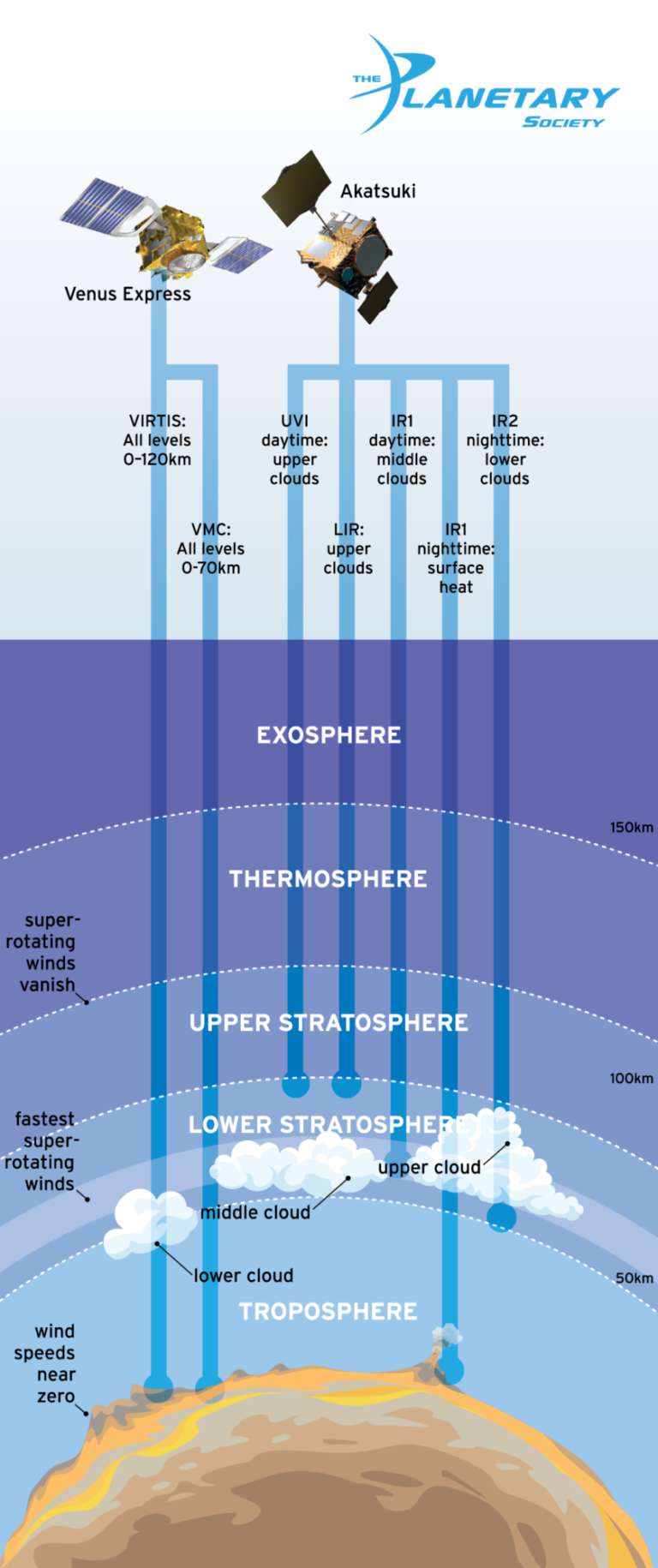
Clouds Upon Clouds
Although NASA’s Pioneer Venus was the first to try to study different cloud levels, the Galileo Jupiter mission achieved the first images showing different cloud structures at different altitudes on dayside and nightside during its flyby on 10 February 1990. Venus’ clouds float in its troposphere between altitudes of 47 and 70 kilometers (29 and 43 miles) and are divided into lower, middle, and upper cloud layers. The upper clouds of Venus are of major interest for several reasons: first, because most of Venus’ absorption of solar energy occurs in these clouds; second, because the superrotation reaches its fastest speeds precisely at the top of the upper clouds; and third, because the upper clouds possess high concentrations of a mysterious absorber–an unknown atmospheric constituent chemical responsible for more than half of the solar energy absorbed by Venus.
Akatsuki’s UVI is uniquely capable of studying the topmost clouds, with one filter that is more sensitive to the distribution of the mysterious absorber, making its presence known as dark streaks on ultraviolet images. Examining both missions’ data, Yeon Joo Lee (Technische Universität Berlin) discovered that the reflectivity of the upper clouds of Venus varies over time. The variation might result from changes in the abundance of the unknown absorber and affects the capacity of the atmosphere to absorb solar energy. This could be the first detection of climate change at another planet.
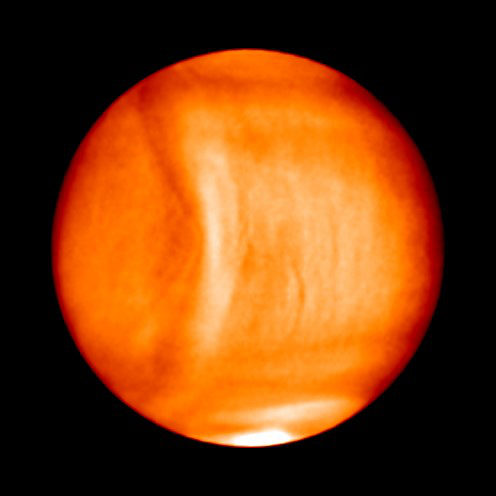
Months before Akatsuki’s arrival, Toru Kouyama (of IAST, Japan) and I discovered (independently, Kouyama using NASA’s Infrared Telescope Facility and myself using Venus Express’ VIRTIS) that some cloud patterns on Venus kept still despite the strong winds at high altitudes. We interpreted the cloud patterns to be stationary waves in the atmosphere called Lee waves, which happen where winds encounter obstacles like high mountains. Our findings were confirmed right after the orbit insertion of Akatsuki, when the very first image acquired by its longwave infrared (LIR) instrument contained the largest stationary wave ever spotted in the solar system.
Why are stationary waves in high clouds important? Their presence suggests that momentum and energy can be transported from Venus’ surface, 70 kilometers (43 miles) below, to the superrotating atmosphere. However, this discovery creates more puzzles than it solves. The Soviet Venera landers measured only very slow winds of 2 to 3 kilometers (1 to 2 miles) per hour at the surface. How can that connect to such high speeds at high altitudes? Even more puzzling is that VIRTIS sees stationary waves in the upper clouds but does not see them in simultaneous observations of the lower clouds.
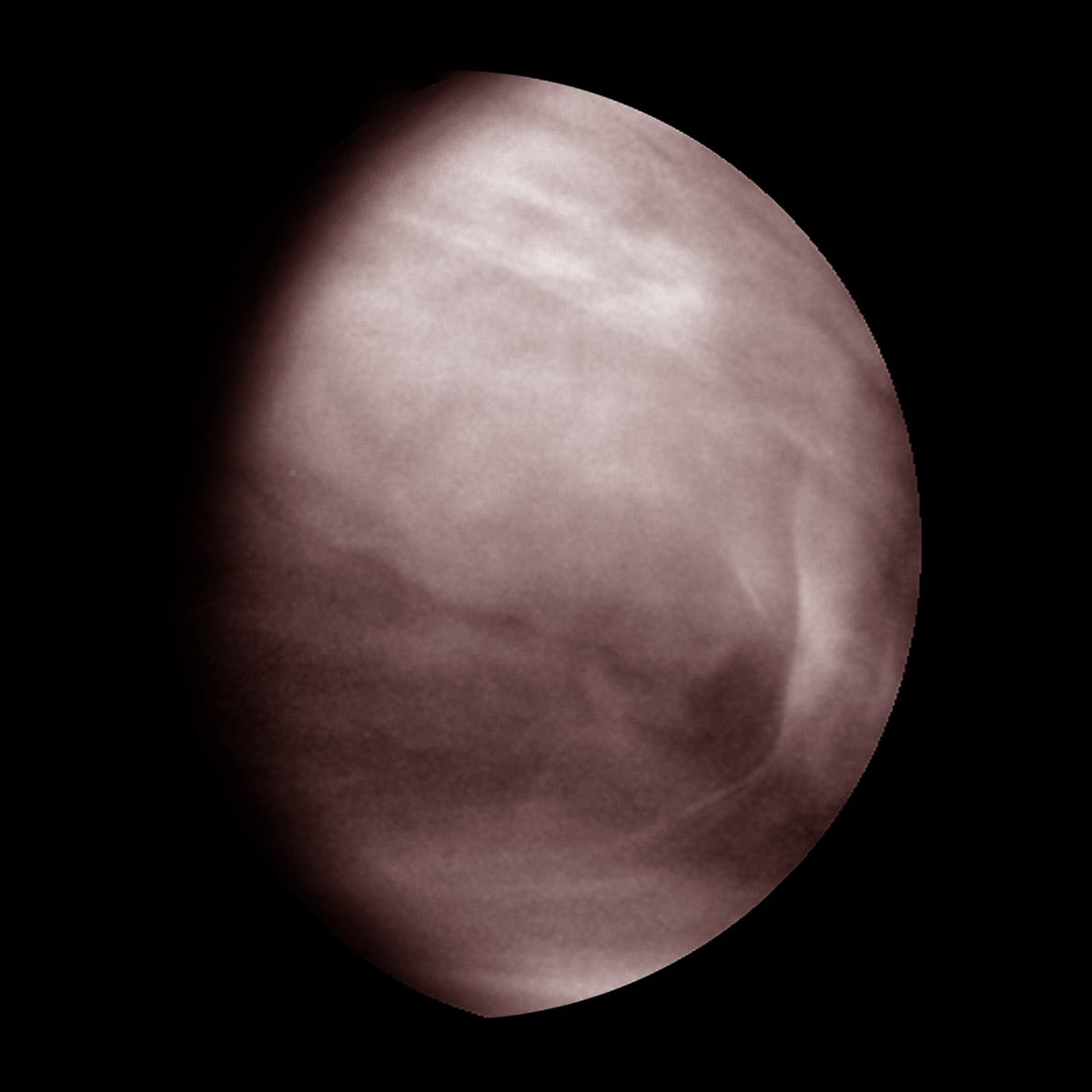
These middle clouds, located at a height of 50 to 56 kilometers (31 to 35 miles), have contained other surprises for us. They appeared featureless to Galileo in 1990 but have shown intriguing patterns to Akatsuki’s IR1. Their surprisingly varied brightness suggests there is some other atmospheric absorber in the middle clouds, a hypothesis supported by measurements from infrared instruments on Venus Express and NASA’s MESSENGER, which studied Venus during a flyby in June 2007. We have a lot to learn about Venus’ atmospheric chemistry and how it varies with altitude.

Both Venus Express and Akatsuki imaged the lower clouds (from 47 to 50 kilometers or 29 to 31 miles) on Venus’ nightside and found patterns that are strikingly different from the upper clouds. The clouds are more opaque near the equator, giving Venus a dark band in Akatsuki IR2 images, and more transparent (lighter) toward the poles. Impressive phenomena lie along the border between the equatorial band and the midlatitude bands, where shear makes billows and vortices, patterns like those seen on Jupiter. At Jupiter, these vortices are caused by the Coriolis effect. Venus rotates so slowly that its vortices can’t have the same cause.
Venus Express’ polar, elliptical orbit gave it brief, very close views of intricate cloud patterns at the north pole and distant views taking in the entire southern hemisphere. On each orbit, VIRTIS stared for hours at a vortex that whirls over Venus’ south pole. We discovered that its shape changes rapidly from a dipole to a tripole to a circle in a matter of days. Itziar Garate-Lopez (UPV/EHU, Spain) used VIRTIS to map the vertical structure of the south polar vortex and found it to be both tall and deep: it extends up to an altitude of 80 kilometers (50 miles), while its base lies at 55 kilometers (34 miles) or perhaps deeper. Intriguingly, the vortex’s location in the upper and lower clouds can be different, so its 3-dimensional structure might be helix-shaped.
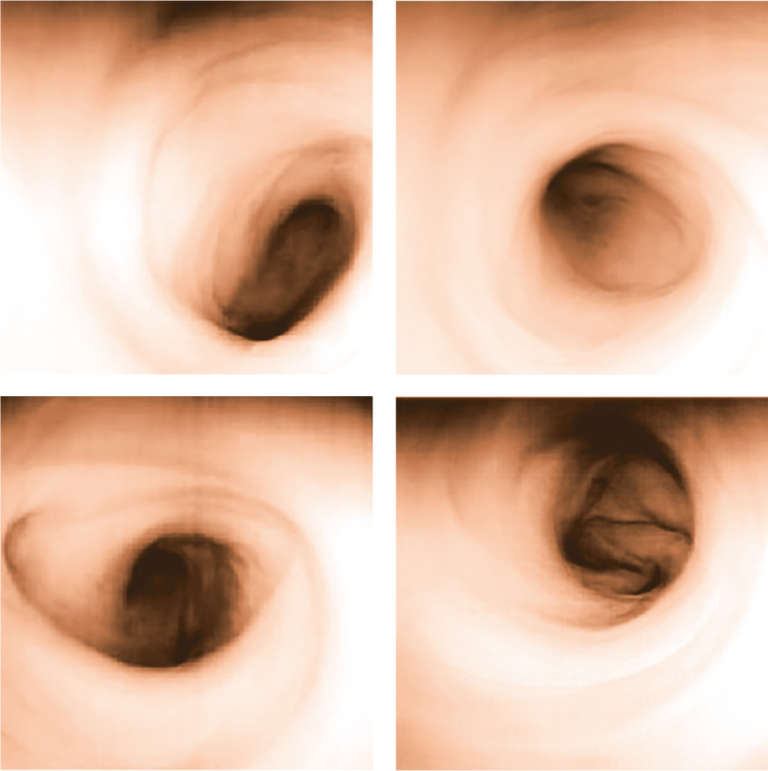
Winding Winds
The unknown absorber in Venus’ clouds helps us measure the speed of its winds through the tracking of cloud features seen in multiple ultraviolet images. We can also measure instantaneous wind speeds with spacecraft or ground-based spectrometers by examining how features in atmospheric spectra are Doppler-shifted by the fast motion of the atmosphere. Venus Express and Akatsuki’s monitoring have together produced more than 4 million cloud-tracking measurements.
Venus Express discovered that the velocity of the superrotation at the dayside upper clouds increased from 300 to about 380 kilometers (190 to 240 miles) per hour from 2006 to 2013. Akatsuki observed that wind speeds had decreased again by 2016, though not to their 2006 levels. This behavior correlates well with the changes in brightness of the upper clouds. The correspondence strongly suggests that the solar tides are a main cause of the superrotation. When there is more of the unknown absorber in the clouds, the atmosphere absorbs more incoming solar energy, powering faster winds. In contrast, the winds within the dayside middle clouds seem to keep more constant over time.
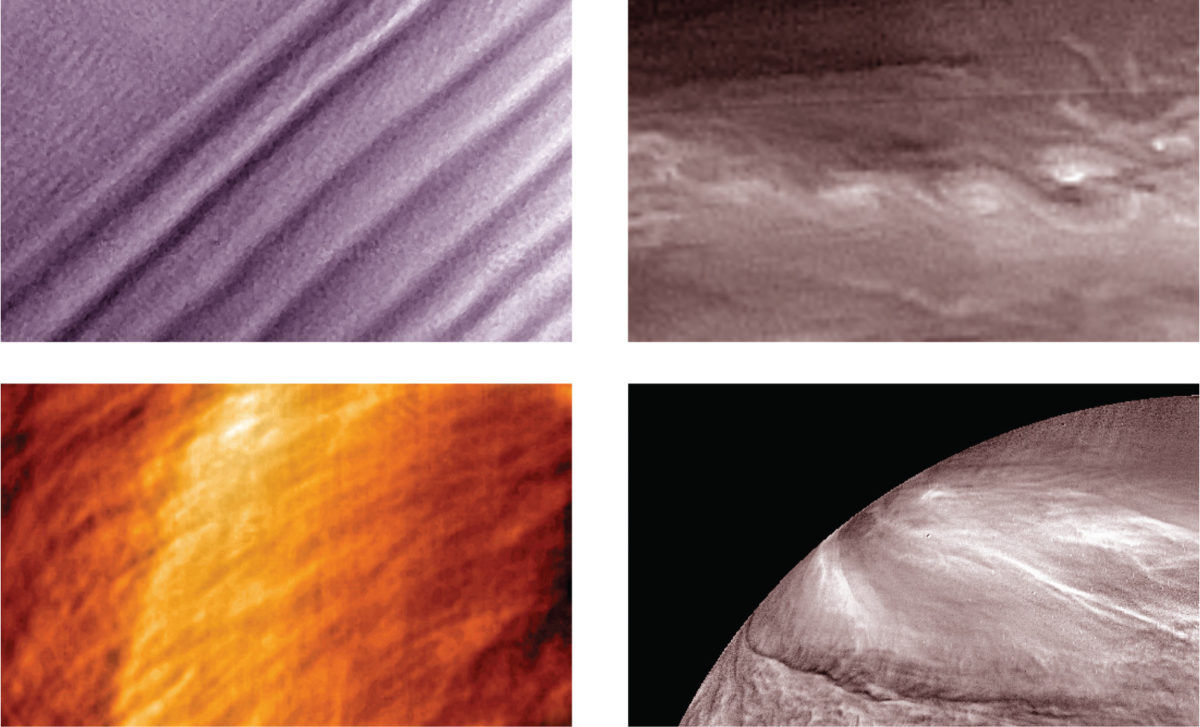
The 2 spacecraft have produced a lesscontinuous record in the lower clouds because the longer-wavelength infrared instruments capable of observing at this altitude (the infrared channel of VIRTIS on Venus Express and the IR2 camera on Akatsuki) both failed after fulfilling their expected lifetimes. VIRTIS studied the clouds from 2006 to 2008, finding that the wind speeds did not vary with latitude during that time period (although they did vary with time). However, when Akatsuki observed the lower clouds in 2016, Takeshi Horinouchi of Hokkaido University discovered that a jet with much faster wind speeds is sometimes present at the equator. This recurrent jet might explain the billows and vortices observed in the lower clouds. We combined Venus Express and Akatsuki data with low-cloud data from Galileo, NASA’s Pioneer Venus entry probes, Soviet VEGA balloons, and numerous groundbased observations to reconstruct the equatorial wind speeds from 1978 to 2017 and found that their speed has varied by more than 100 kilometers (60 miles) per hour in that time.
To get a more complete picture of the 3-dimensional circulation of Venus’ winds through all levels of the nightside and dayside of Venus, we had help from the worldwide campaign of observations organized for the second Venus flyby of MESSENGER in June 2007. We performed feature tracking on images from Venus Express, MESSENGER, and amateur observations with small telescopes. We obtained Doppler wind speeds from spectra taken at large, ground-based telescopes, and we predicted wind speeds using temperature measurements from orbit and ground. We learned that the atmospheric circulation on the nightside of Venus is surprisingly different from the dayside.
With VIRTIS, we were able to image the upper-level clouds on the nightside with high resolution for the very first time. Our measurements revealed that superrotation on the nightside, rather than being homogeneous like on the dayside, sometimes becomes chaotic, with wind speeds as slow as 70 kilometers (43 miles) per hour in some places. VIRTIS was also able to observe a particular emission from oxygen molecules that occurs at an altitude of about 100 kilometers (60 miles) on the nightside well above the clouds, where superrotation is supposed to vanish. Ricardo Hueso (UPV/EHU, Spain) and Dmitry Gorinov (Space Research Institute, Russia) performed enormously challenging tracking of these fast airglow emissions and confirmed that at this altitude, the east-to-west superrotation is replaced by another mean circulation called “solar to antisolar.” As is hypothesized to happen on hot Jupiter exoplanets tidally locked to their stars, Venus’ highest-altitude winds blow from the area where solar insolation is maximum (the subsolar point) to the antipode at the antisolar point.
What's Next?
In the short term, worldwide campaigns of observations are being prepared to coordinate with the Venus flybys of the ESA/JAXA Mercury mission BepiColombo in October 2020 and August 2021 and probably also NASA’s Parker Solar Probe in December of this year. However, despite all we have learned from more than 60 years of spacecraft study, there are critical gaps in our knowledge of Venus’ atmosphere.
We know almost nothing about the deep atmosphere of Venus below 40 kilometers (25 miles), which contains more than 75 percent of the total mass of the atmosphere and controls the interaction between the surface and the atmosphere. Only in situ measurements from probes and landers can provide information for this region. Descent probes and short-lived (1 hour) and long-lived (1 year) landers have been proposed; more futuristic projects consider low-altitude balloons or surface rovers. New missions capable of making in situ measurements after a gap of more than 30 years will likely change our view of the planet all over again. After all, Venus’ appearances are deceptive.
Let’s Go Beyond The Horizon
Every success in space exploration is the result of the community of space enthusiasts, like you, who believe it is important. You can help usher in the next great era of space exploration with your gift today.
Donate TodayThe Planetary Report • September Equinox
Help advance space science and exploration! Become a member of The Planetary Society and you'll receive the full PDF and print versions of The Planetary Report.


 Explore Worlds
Explore Worlds Find Life
Find Life Defend Earth
Defend Earth


